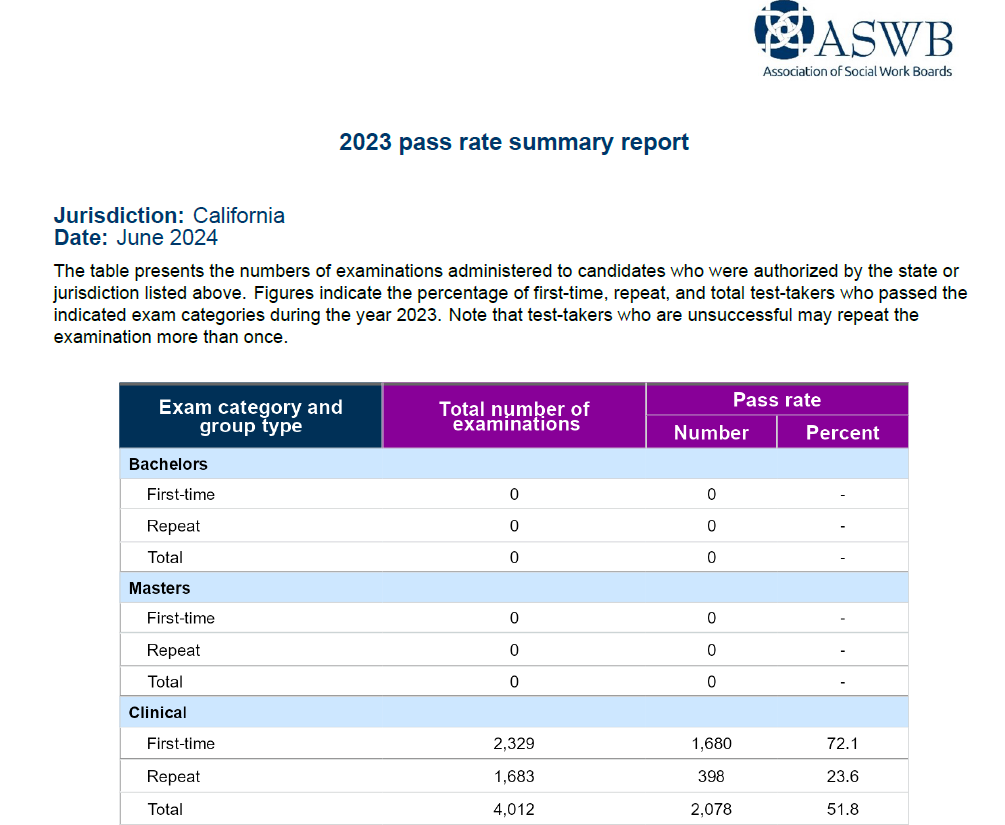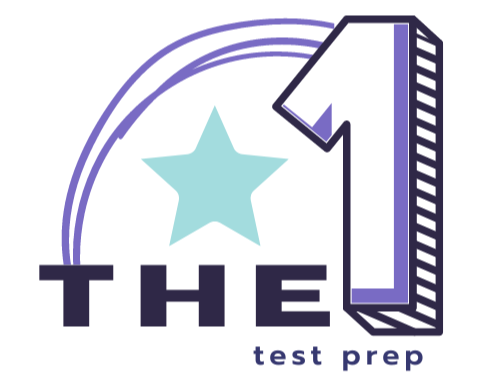ASWB Pass Rates Breakdown - California
Mar 20
/
Jason Adkins LCSW
The 2023 pass rate summary for social work licensing exams in California, provided by the Association of Social Work Boards (ASWB), offers valuable insight into the challenges and opportunities facing the profession. As licensing remains a critical step in ensuring competent practitioners, these statistics highlight barriers that may impact the workforce pipeline and the accessibility of social work services across the state.
Barriers to Entry and Workforce Diversity
The data reveals significant disparities in pass rates between first-time and repeat test-takers, suggesting that those who fail initially struggle to pass in subsequent attempts. This trend raises concerns about equitable access to licensure, particularly for candidates from underrepresented backgrounds. If systemic barriers—such as financial burdens, test anxiety, or gaps in test preparation—disproportionately affect certain groups, the profession risks losing diverse voices that are crucial to serving California’s varied communities.

👉 When you are ready to join the most trusted ASWB exam prep Study Groups with the highest pass rate in the nation, click here.
Addressing Social Work Shortages
California, like much of the nation, faces a growing demand for social workers in mental health services, child welfare, and elder care. However, if pass rates remain low, the state may struggle to fill essential roles, exacerbating workforce shortages. Addressing this challenge requires a multi-faceted approach, including improved test preparation resources, financial support for candidates, and alternative pathways to licensure that emphasize practical competencies over standardized testing.
Rethinking the Licensing System
These findings also prompt a broader discussion about whether standardized exams are the best measure of a social worker’s ability to practice effectively. If the exam disproportionately hinders qualified individuals from entering the field, stakeholders—including licensing boards, educators, and policymakers—must evaluate alternative models. Potential solutions include competency-based assessments, supervised fieldwork evaluations, or revised test structures that better reflect the realities of social work practice.
Ultimately, California’s exam pass rates highlight the need for systemic changes that ensure licensing remains a pathway to professional growth rather than a barrier to entry. By addressing these challenges, the state can strengthen its social work workforce and better meet the needs of its diverse population.
👉 Connect with more valuable ASWB content on our YouTube channel
👉 Connect with more valuable ASWB content on our YouTube channel
#LCSW #LMSW #LBSW #LICSW #LISW #LAPSW #ACSW #LSCSW #CSWA #LGSW #LCSWC #LSWAA #SWA #SocialWork #ASWB #SocialWorker #SocialWorkLicense #SocialWorkLicenseExam #ASWBExam #ExamPrep #LCSWExam #LMSWExam #ASWBCourse #Examination #LicensedSocialWorker #MSW #BSW
Join The One
Join Our Team
Free-ish Page
Affiliate Program
Tools for The One
Blog Page
Free Practice Exam
Anxiety Management
Learning Styles Assessment
Become The One
Live Study Groups
Bachelors Pathway
Masters Pathway
Clinical Pathway
Partner with The One
University and Organization Partnership
Events - Calendar for Live Workshops
Copyright © 2024 The One Test Prep
All About: Visual Learning Style
-
Create graphic organizers such as diagrams and concept maps that use visual symbols to represent ideas and information.
-
Use different colored highlighters to make a visual association with material in textbooks (for instance, blue might signal important terms, while green might signal important dates or people).
-
Pay close attention to descriptive words in texts to help you recall information (for instance, you might remember details about the “Hero” in families dealing with alcoholism because of their willingness to take on the responsibilities that the alcohol abuser no longer does-then visualize them as an actual super hero).
-
Convert lecture notes into a visual format by drawing your own diagrams or by using symbols to organize material (© could signal all of the speakers remarks about cognitive behavior theory).
-
Make illustrated flash cards for vocabulary words. For example, you might remember the definition of ‘folie a deux’ (which is a delusion shared by two people) by drawing two people dressed up as Elvis on one side of the flash card.
-
Study in a place that is free from visual distractions.
-
Type your written notes from class using different fonts, bold print, and underlining to make the most important concepts and facts visually apparent.
-
When trying to remember information, close your eyes and visualize the information.
-
Watch films, especially documentaries, as supplements to your reading.
All About: Kinesthetic Learning Style
-
Get a partner to help you with role playing. This can be done for symptoms of a diagnosis, defense mechanisms, stages of development, ethical scenarios and much more. These serve as experiential learning tools for the kinesthetic learner.
-
Kinesthetic learning can be enhanced by physically changing your surroundings to include sitting in nature or crowded spaces. Take frequent study breaks to move around or exercise.
-
Get someone NOT trained in social work and demonstrate to them what you have learned. Teaching others can be the best way to learn.
-
Touch plays a key role in your learning, so try to create a tactile association with course material. You might use different colored post-it notes to mark important parts of your textbook or create flashcards (you will recall the information because you have the memory of creating the cards, and you will have the physical cards to hold and flip through, further reinforcing that memory).
-
Whenever possible, try to apply what you have learned to real-life situations.
-
While listening to lectures, imagine yourself moving about in some way related to the material mentioned. For instance, you might visualize yourself in the treatment session applying the Cognitive Behavioral Therapy interventions with a client who is experiencing depression or anxiety.
-
Assemble charts and diagrams of your work to further coordinate your learning process.
All About: Reading/Writing Learning Style
-
Concentrate more on written texts and captions than on illustrations.
-
Outline chapters prior to reading them, focusing on subheadings and any terms in boldface or italics to identify the author’s major ideas.
-
Write out lecture notes in complete sentences. This will help familiarize you with important concepts and facts, as well as fixing them in your memory.
-
Practice your recall by listing key terms and details.
-
Create flash cards containing key terms.
-
When preparing for exams, try writing a summary of what material you feel confident about and what material you don’t. Then, try writing out exactly what confuses you and why. This will help identify the material you need to focus on the most, and it may even lead you to a remedy for your confusion.
-
Re-write key social work terms and theories in your OWN words when taking notes and making flash cards.
All About: Auditory Learning Style
-
Tape lectures with the instructor’s permission to play back while studying.
-
Read your flashcards/notes out loud to yourself and tape yourself reading them for playback while driving or exercising.
-
Play music in the background while you study (thinking about this music may help jog your memory when taking an exam).
-
Repeat facts and definitions of social work terms over and over to yourself with your eyes closed.
-
Join or form a study group, so that you can discuss with others what you have learned.
-
Engage a fellow social worker in exam content discussion.
-
Make full use of the various podcasts included in your study system.
